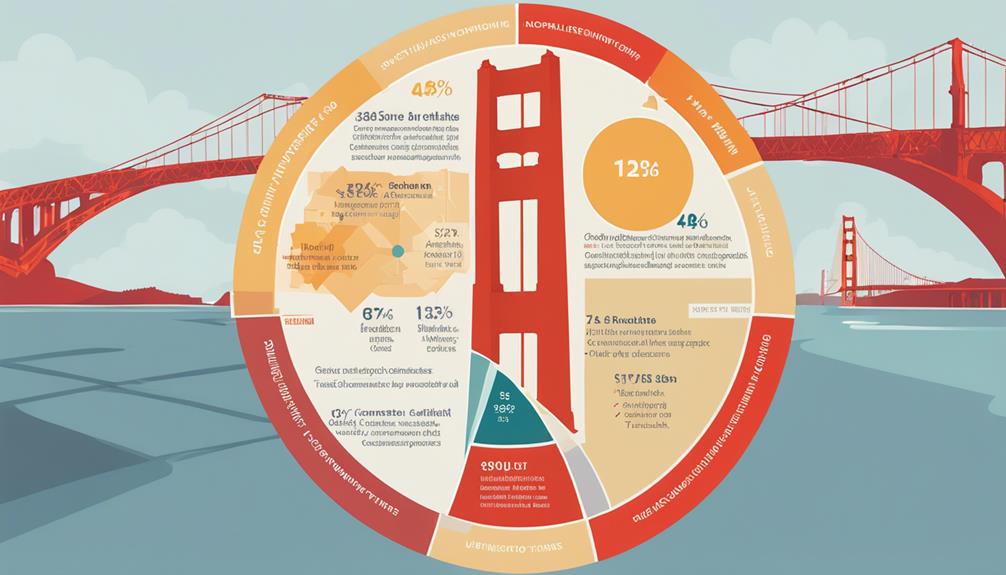As a California resident, you'll want to stay on top of the upcoming changes to the state's tax brackets. In 2024, the lowest income earners will benefit from a slightly higher threshold, while middle-income individuals can expect to pay a lower rate on a portion of their earnings. At the top, the wealthy will shoulder a larger share of the tax burden. Understanding how these modifications might impact your situation is essential – and the key details you need to know may surprise you.
Key Takeaways
- California's lowest income bracket applies to individuals with taxable income between $0 and $10,099, with a 1% tax rate and potential for low-income assistance.
- Middle-income brackets have been adjusted for 2024, raising thresholds to provide relief for middle-class taxpayers impacted by inflation.
- The top marginal tax rate has increased to 14.3% for incomes over $599,017, reflecting ongoing discussions around wealth tax proposals.
- Taxpayers can reduce their taxable income by claiming eligible deductions, such as medical expenses, mortgage interest, and charitable contributions.
- Consulting a tax professional can help maximize deductions and credits to optimize one's tax liability.
Lowest Income Bracket

The lowest income bracket in California's 2024 tax structure applies to individuals with a taxable income of $0 to $10,099. If you fall within this bracket, you'll pay a tax rate of 1%, which is the lowest rate in the state. This means that for every $100 you earn, you'll owe $1 in state taxes.
While the tax burden may seem low, you may still qualify for low income assistance and earned income credits. These programs can provide additional financial support to help offset the cost of living and boost your overall take-home pay. Be sure to explore your eligibility for these benefits, as they can make a significant difference in your financial well-being.
Middle-Income Bracket Adjustments
As California's middle-income earners brace for the 2024 tax year, they'll be pleased to know that the state has raised the income thresholds for this bracket. Additionally, the tax rates within this range have been adjusted to offer a bit more relief. Guarantee, these changes are designed to account for inflation and provide a fair tax system for all.
Increased Income Thresholds
California's middle-income tax brackets now feature increased income thresholds for 2024. The new thresholds aim to provide relief for middle-class taxpayers, who've seen their purchasing power erode due to rising costs. Let's take a closer look at the changes:
| Taxable Income | 2023 Bracket | 2024 Bracket |
|---|---|---|
| $0 – $19,990 | 1% | 1% |
| $19,991 – $48,435 | 4% | 4% |
| $48,436 – $312,686 | 6% | 8% |
| Over $312,686 | 9.3% | 9.3% |
The most significant increase is in the 6% bracket, which now starts at $48,436 and goes up to $312,686, a significant jump from the previous $48,435 threshold. This change, coupled with increased tax credits and higher deduction limits, aims to ease the tax burden on middle-income Californians, helping them keep more of their hard-earned money.
Adjusted Tax Rates
Expanding on the increased income thresholds, you'll find the middle-income tax brackets have been adjusted for 2024. For single filers, the 22% bracket now applies to incomes between $44,725 and $95,375, up from the previous $40,525 to $86,375 range. Similarly, the 24% bracket for married couples filing jointly now spans incomes from $89,450 to $190,750, a significant increase from the prior $81,050 to $172,750 range.
These bracket adjustments result in lower effective tax rates for many middle-income Californians. For example, a single filer with an income of $60,000 will see their marginal tax rate decrease from 22% to 12%, thanks to the expanded 12% bracket. Married couples filing jointly with a $120,000 income will also benefit, as their marginal rate drops from 22% to 12%. These adjustments aim to provide much-needed tax relief for the state's middle class.
Inflation Adjustments
The 2024 tax brackets have been adjusted to account for inflation, providing valuable relief for middle-income Californians. These cost of living adjustments are part of the periodic indexation process that guarantees the tax system keeps pace with the changing economic landscape. By adjusting the income thresholds for each tax bracket, you'll be able to retain more of your hard-earned money, helping you better manage your finances and meet the rising costs of living.
These inflation-based updates are critical, as they prevent the dreaded "bracket creep" that can push you into a higher tax bracket even if your real income hasn't increased. With the new adjustments, you'll find that your taxable income is now subject to a lower rate, allowing you to keep more of what you've earned. This enhanced financial flexibility can make a significant difference in your overall quality of life, empowering you to allocate your resources more effectively.
High-Income Bracket Changes

Unsurprisingly, California's high-income tax brackets have undergone significant alterations for 2024. The state's progressive tax structure has been further refined, with the highest marginal rate now kicking in at a higher income threshold. This change reflects ongoing discussions around wealth tax proposals and their impact on California's wealthiest residents.
To better understand the new high-income brackets, consider the following table:
| Income Level | 2023 Tax Rate | 2024 Tax Rate |
|---|---|---|
| $1 – $59,978 | 1% – 9.3% | 1% – 9.3% |
| $59,979 – $299,508 | 10.3% | 10.3% |
| $299,509 – $599,016 | 11.3% | 11.3% |
| $599,017 and above | 13.3% | 14.3% |
The most notable change is the increase in the top marginal rate, which now stands at 14.3% for individuals earning $599,017 or more. This adjustment aims to guarantee that California's wealthiest residents contribute a larger share towards the state's public services and infrastructure.
Calculating Taxable Income
To calculate your taxable income, you'll need to start with your gross income and subtract any eligible deductions. This will give you your adjusted gross income, which you can then further reduce by claiming exemptions and credits. Mastering these steps is key to ensuring you pay the right amount in California taxes.
Gross Income Deductions
Calculating your taxable income begins with determining your gross income and then subtracting eligible deductions. When it comes to gross income deductions, there are several key areas to consider.
- Medical expenses: You can deduct qualifying medical expenses that exceed 7.5% of your adjusted gross income.
- Home mortgage interest: Interest paid on a mortgage for your primary residence or a second home may be deductible.
- Charitable contributions: Donations to qualified charitable organizations can be deducted, subject to certain limitations.
- Capital gains deductions: If you've incurred capital losses, you may be able to deduct them against your capital gains.
- State and local tax deductions: You can deduct up to $10,000 in state and local taxes, including property taxes.
Keeping detailed records and understanding the various deductions available can help you minimize your California tax liability. Consulting a tax professional can also guarantee you take advantage of all the deductions you're qualified for.
Taxable Income Calculation
After subtracting eligible deductions from your gross income, you'll arrive at your taxable income. This is the amount that will be subject to California's progressive tax rates. The taxable income determination process involves carefully evaluating your earnings and deducting qualified expenses.
To calculate your taxable earnings, use the following table:
| Filing Status | Taxable Income Range | Tax Rate |
|---|---|---|
| Single | $0 – $8,932 | 1% |
| $8,932 – $21,226 | 2% | |
| $21,226 and above | Varies | |
| Married/RDP | $0 – $17,864 | 1% |
| $17,864 – $42,452 | 2% | |
| $42,452 and above | Varies |
Exemptions and Credits
Claiming eligible exemptions and tax credits can substantially lower your taxable income. These deductions and credits can be complex, but understanding them can save you a significant amount on your California state taxes.
Exemptions, such as spousal exemptions, can reduce your taxable income by a set amount for each eligible dependent. Similarly, tax credits, like the dependent care credits, directly reduce the amount of tax you owe, dollar for dollar.
Some key points to verify when claiming exemptions and credits:
- Confirm you meet the eligibility requirements for each deduction or credit.
- Gather all necessary documentation, such as Social Security numbers and proof of expenses.
- Take advantage of credits for childcare, education, and healthcare costs.
- Contemplate the impact of changes in your household, such as a new dependent or job loss.
- Seek the guidance of a tax professional if you have complex tax situations.
Maximizing your exemptions and credits can make a significant difference in your California state tax liability.
Understanding Tax Deductions

Tax deductions can provide significant savings when filing your taxes. The standard deduction is a fixed amount that can reduce your taxable income, regardless of your actual expenses. For 2024, the standard deduction for single filers in California is $12,200, and for married couples filing jointly, it's $24,400. Personal exemptions, which were previously available, have been suspended under the Tax Cuts and Jobs Act until 2025.
Beyond the standard deduction, there are various itemized deductions you can claim, such as mortgage interest, state and local taxes, charitable contributions, and more. However, it's important to keep detailed records and guarantee that your deductions meet the IRS requirements. Consulting a tax professional can help you maximize your tax savings and avoid any potential issues.
Navigating Filing Requirements
Traversing the filing requirements for your taxes in California may appear formidable, but with a bit of preparation, you can guarantee a seamless process. Understanding the key deadlines and ensuring you make any necessary estimated payments can help you stay ahead of the curve.
One of the crucial aspects of maneuvering the filing requirements is being aware of the relevant deadlines. These include:
- The standard April 15th deadline for submitting your annual tax return
- Quarterly estimated payment deadlines, typically due on April 15th, June 15th, September 15th, and January 15th
- Extended filing deadlines, if applicable, which may push the deadline to October 15th
Additionally, you'll want to familiarize yourself with the forms and documents required for your specific tax situation. This may include W-2s, 1099s, and any deductions or credits you plan to claim.
Strategies for Tax Planning

With proper tax planning strategies, you can potentially minimize your tax liability and maximize your financial well-being. One key aspect to contemplate is estate planning. By incorporating estate planning into your tax strategy, you can guarantee your assets are distributed according to your wishes and potentially reduce your tax burden. Additionally, optimizing your investment portfolio can yield significant tax savings.
| Tax Planning Strategies | Potential Benefits |
|---|---|
| Estate Planning | Guarantee asset distribution, Minimize tax burden |
| Investment Portfolio Optimization | Reduce taxable income, Capitalize on tax-efficient investments |
| Charitable Contributions | Claim deductions, Support causes you care about |
Implications for Taxpayers
Understanding the California tax brackets for 2024 is essential, as it can materially impact your financial planning. Knowing how these brackets affect your tax burden can help you make more informed decisions and optimize your effective tax planning.
The implications for taxpayers are significant. By understanding the nuances of the tax brackets, you can explore various strategies to reduce your overall tax burden, such as:
- Maximizing deductions and credits
- Considering tax-advantaged investment options
- Timing income and expenses to fall within more favorable tax brackets
- Exploring opportunities for tax-efficient retirement planning
- Staying informed about any changes or updates to California's tax laws and regulations
Effective tax planning is crucial in managing the complexities of the California tax system. By proactively managing your tax liability, you can maximize your take-home pay and allocate more resources towards your financial goals, whether it's saving for the future, investing, or enjoying a more comfortable lifestyle.
